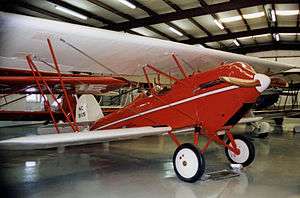Brunner-Winkle Bird
| Brunner-Winkle Bird | |
|---|---|
 | |
| Bird A of 1929 fitted with Curtiss OX-5 engine preserved at the Historic Aircraft Restoration Museum near St Louis, Missouri. | |
| Role | air-taxi/joyrider |
| National origin | United States |
| Manufacturer | Brunner-Winkle |
| Designer | Michael Gregor |
| First flight | September 1928 |
| Status | some aircraft still flying and on display in museums |
| Primary user | private flyers and barnstorming |
| Number built | ca. 240 |
|
| |
The Brunner-Winkle Bird was a three-seat taxi and joy-riding aircraft produced in the USA from 1928 to 1931.
Design and operation
The Model A version was powered by the ubiquitous Curtiss OX-5, and featured a welded steel-tube truss fuselage with metal and fabric skinning. The wings, constructed of Spruce and plywood were also covered with metal and fabric skinning. The Model A had a reasonable performance for an OX-5 powered aircraft. The Model A's ease of handling led to its entry into the 1929 Guggenheim Safety Airplane contest, where it was awarded the highest ratings for a standard production aircraft.
The Model A was awarded Group 2 approval no 2-33 in January 1929 for the first nine aircraft serial no. 1000 to 1008. Aircraft serial no. 1009 upwards were manufactured under Air Transport Certificate no. 101.
The Model B followed on from the initial Bird design and was fitted with the uncowled Kinner radial engine. Production aircraft were designated BK.
Variants
Data from: aerofiles.com

- Model A - original production version with Curtiss OX-5 engine (ca. 80 built)
- Model AT - version with Milwaukee Tank engine (2 converted from Model A)
- Model B - version with Kinner K-5 engine (1 prototype)
- Model BK - production version of Model B (84 built)
- Model C - version with Wright J-5 engine (1 built)
- Model CC - version with Curtiss R-600 Challenger engine (1 built)
- Model CJ - version with Jacobs LA-1 engine (6 built)
- Model CK - version with Kinner B-5 engine (50 built)
- Model RK - export version of Model CK (1 built)
- Model E - 4-5 seat version with enclosed cabin and Kinner B-5 engine (1 built)
- Model F - version with Packard DR-980 (1 built)
Specifications (Bird Model A)
General characteristics
- Crew: 1
- Capacity: 2 passengers
- Length: 22 ft 3 in (6.78 m)
- Wingspan: 34 ft 0 in (10.36 m)
- Height: 8 ft 8 in (2.64 m)
- Wing area: 266 ft2 (24.7 m2)
- Empty weight: 1,315 lb (598 kg)
- Gross weight: 2,150 lb (977 kg)
- Powerplant: 1 × Curtiss OX-5, 90 hp (67 kW)
Performance
- Maximum speed: 105 mph (168 km/h)
- Cruise speed: 88 mph ( km/h)
- Range: 450 miles (720 km)
- Service ceiling: 12,500 ft (3,800 m)
- Rate of climb: 520 ft/min ( m/s)
Notes
References
| Wikimedia Commons has media related to Brunner-Winkle Bird. |
- "Aircraft Ba-Bl". aerofiles.com. Retrieved 2008-10-19.
- U.S. Civil Aircraft VOL.2. Los Angeles CA: Aero Publishers. pp. 9 to 11.
- "The BrunnerWinkleBird". cradleofaviation.org. Retrieved 2008-10-19.
- "Brunner-Winkle Bird BK". yanksair.com. Retrieved 2016-07-31